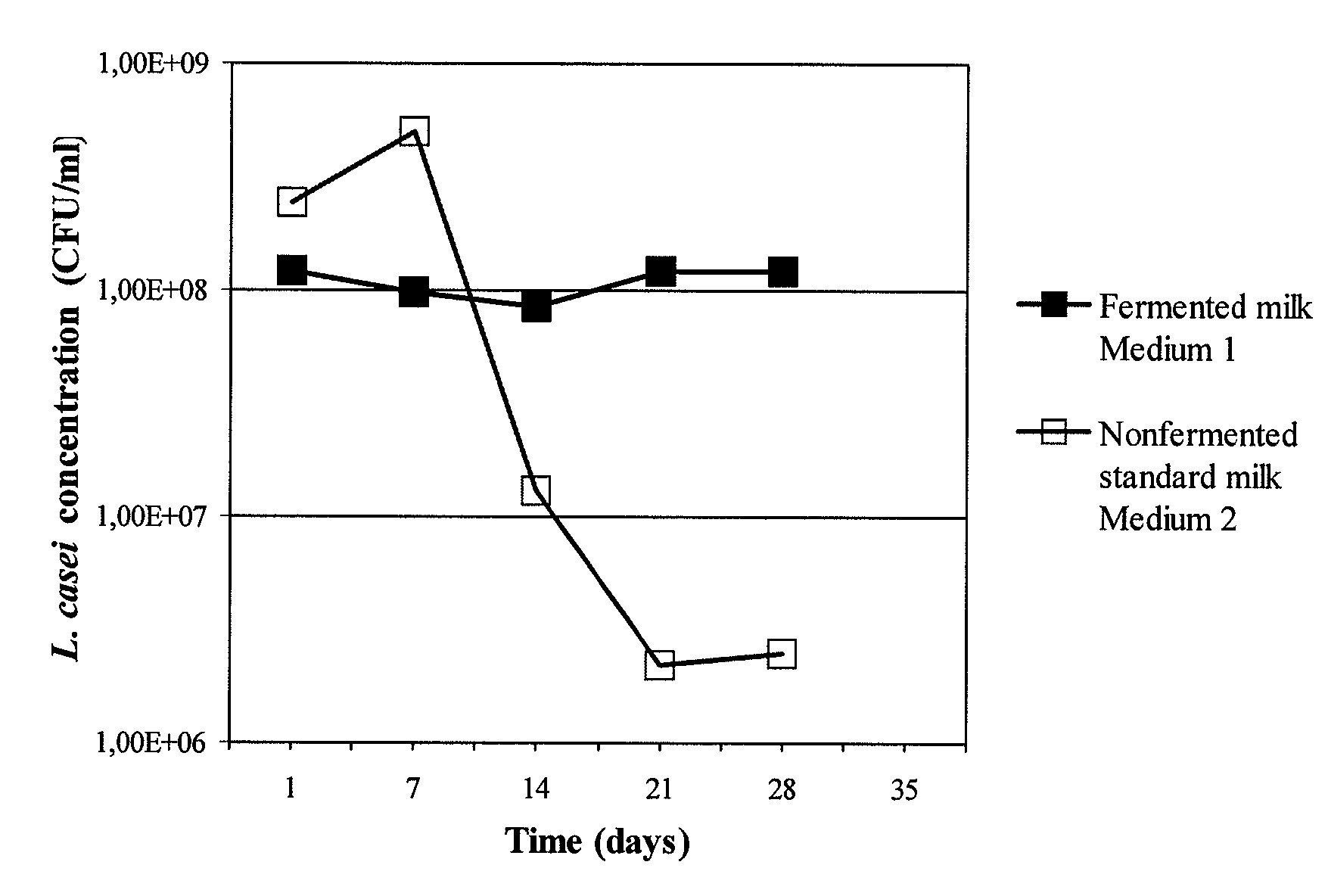Food product containing lactic bacteria granules
- Summary
- Abstract
- Description
- Claims
- Application Information
AI Technical Summary
Benefits of technology
Problems solved by technology
Method used
Image
Examples
example 1
Preparation of a Fermented Milk Product in Accordance with the Invention
1) Preparation of Particles of Dehydrated Lactic Acid Bacteria
[0045] The L. casei strain I-1518 was cultured for 15 hours at a temperature of 37° C. on a Man Rogosa Sharpe (MRS) type culture medium, prior to it being lyophilized for 66 hours. The characteristics of the lyophilizate are as follows: [0046] Water content: 2% (measured using a Sartorius® desiccator sold by the company Sartorius); [0047] Aw: 0.1 measured with a Novasina® sold by the company Novasina; [0048] Particle size: 80 microns; [0049] Population: 1.7×1011 CFU / g of lyophilized particles.
2) Preparation of the Granules of Dehydrated Lactic Acid Bacteria
[0050] The particles of lyophilized bacteria thus obtained above in step 1) are then coated on a fluidized bed in a 50 / 50 mixture of stearic acid and palmitic acid (% w / w) according to the process described in Example 2 of International Application WO 01 / 68808.
[0051] The degree of coating (% of...
example 2
Preparation of a Food Product in Accordance with the Invention: Fermented Milk
[0062] 1% by weight of L. casei granules manufactured according to Example 1 above was introduced into a stirred milk fermented beforehand for 10 hours at 37° C. with the strains L. bulgaricus, S. thermophilus and L. casei (in uncoated form).
[0063] The fermented milk was then distributed into 200 ml pots.
[0064] The population of L. bulgaricus, S. thermophilus and L. casei (in uncoated form) is greater than 1×107 CFU / ml of product.
[0065] The measured amount of L. casei in the form of granules was 109 CFU / g of finished product.
[0066] A study of the evolution of the amount of L. casei bacteria per ml of finished product as a function of time was then carried out. The results obtained (not represented) show that the granulation step does not decrease the survival of the lactic acid bacteria in the finished product for at least 35 days.
[0067] Furthermore, a similar study carried out on the populations of ...
example 3
Preparation of a Food Product in Accordance with the Invention: Fruit Juice
[0068]L. casei granules manufactured according to Example 1 above are introduced in a proportion of 0.1% by weight per liter of orange juice at pH 3.5 (pure orange juice) so as to produce a fruit juice containing 108 CFU of coated L. casei per gram of fruit juice.
[0069] The study of the evolution of the amount of L. casei per ml of finished product as a function of time shows that the granulation of the lactic acid bacteria does not decrease their survival in the finished product for at least 30 days.
[0070] The results of the organoleptic tests carried out with a panel of 10 tasters show, moreover, that the fruit juice in accordance with the invention is very similar (presence of a strange taste, sweet taste, texture and acidity) to a comparative standard fruit juice containing the same amount of lactic acid bacteria in uncoated form. Finally, the fruit juice in accordance with the invention had not develo...
PUM
 Login to View More
Login to View More Abstract
Description
Claims
Application Information
 Login to View More
Login to View More - R&D
- Intellectual Property
- Life Sciences
- Materials
- Tech Scout
- Unparalleled Data Quality
- Higher Quality Content
- 60% Fewer Hallucinations
Browse by: Latest US Patents, China's latest patents, Technical Efficacy Thesaurus, Application Domain, Technology Topic, Popular Technical Reports.
© 2025 PatSnap. All rights reserved.Legal|Privacy policy|Modern Slavery Act Transparency Statement|Sitemap|About US| Contact US: help@patsnap.com

